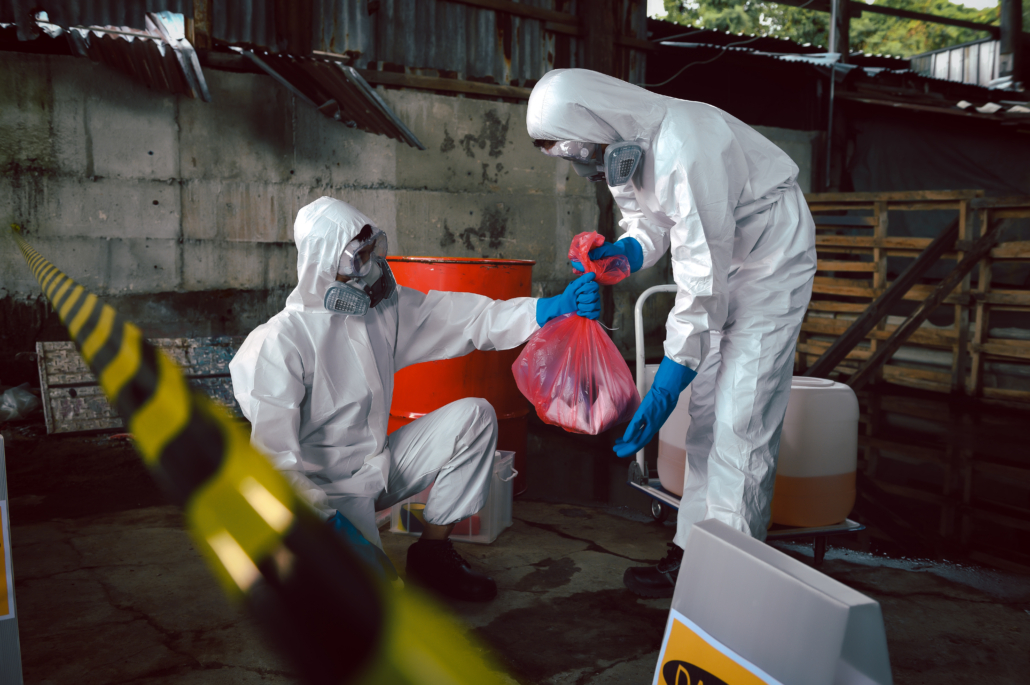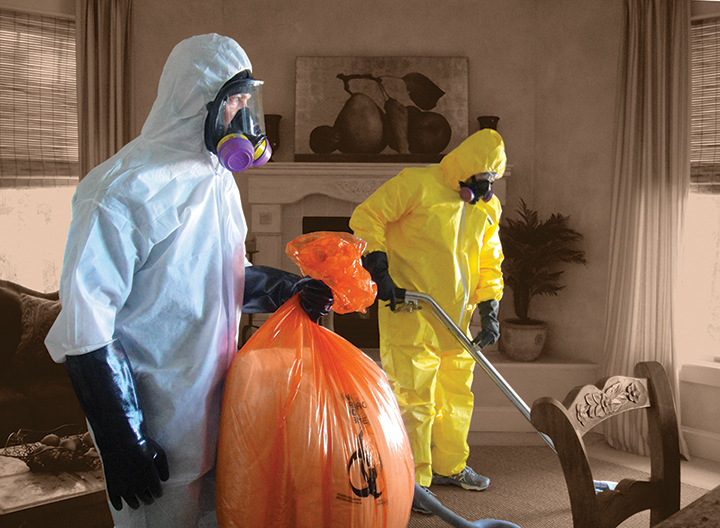Hoarder Cleanup Services: Improving Order and Security in Your Home
Hoarder Cleanup Services: Improving Order and Security in Your Home
Blog Article
Professional Biohazard Cleaning and Decontamination for Blood, Bodily Fluids, and Hazardous Materials
The possible wellness dangers connected with direct exposure to biohazards underscore the important need for careful handling and thorough cleanup. As we browse the complex landscape of biohazard cleaning, recognizing the nuances of guidelines, compliance, and the customized devices at play ends up being important in ensuring a risk-free and thorough decontamination procedure.
Wellness Risks of Biohazard Exposure
Direct exposure to biohazards presents considerable health and wellness risks that can result in extreme effects for neighborhoods and people alike. Biohazards encompass a large array of organic materials, including blood, bodily liquids, mold and mildew, microorganisms, viruses, and other potentially contagious products. When individuals enter contact with these biohazards, whether through accidents, inappropriate handling, or environmental exposure, they deal with the danger of contracting major diseases or conditions.
One of the key wellness risks related to biohazard direct exposure is the transmission of infectious conditions. Bloodborne virus such as HIV, liver disease B and C, and various bacteria can be existing in biohazardous materials, posturing a straight threat to human health and wellness. Inhaling air-borne biohazards like mold spores or entering contact with polluted surfaces can likewise result in respiratory system issues, allergic reactions, and other unfavorable health and wellness effects.
Furthermore, biohazard exposure can have lasting health and wellness implications, with some diseases materializing years after the first get in touch with (Blood Cleanup). Consequently, it is important to prioritize correct biohazard cleaning and decontamination to minimize these wellness threats and guarantee the security of neighborhoods and individuals

Specialized Educating for Biohazard Cleanup
When it comes to dealing with biohazard cleaning efficiently and securely, specialized training plays a basic duty in making sure correct decontamination treatments are followed. Biohazard clean-up calls for specific knowledge and abilities to efficiently reduce risks connected with bloodborne pathogens, physical liquids, and unsafe materials. Experts trained in biohazard cleaning undergo strenuous instruction on how to safely handle, remove, and take care of biohazardous products to prevent contamination and exposure.
Specialized training for biohazard cleanup covers a series of essential topics, including correct individual safety devices (PPE) use, bloodborne virus understanding, purification methods, and hazardous waste disposal methods. People learnt biohazard cleaning are equipped with the needed competence to evaluate contamination levels, recognize potential threats, and carry out appropriate cleaning procedures in conformity with regulative standards.
Continuous training and education are critical in the area of biohazard clean-up to remain updated on the most recent purification technologies, safety protocols, and laws. By buying specialized training, biohazard cleanup experts can successfully react to emergency situation cleanup circumstances and safeguard both public health and the environment.
Relevance of Appropriate Purification Techniques
Utilizing proper decontamination strategies is critical in biohazard clean-up to effectively remove hazardous products and minimize health and wellness risks. Effective decontamination not just makes certain the removal of visible traces of blood, bodily fluids, and various other biohazards yet additionally targets unseen pathogens that might position severe health and wellness dangers if not properly gotten rid of. By following rigorous purification procedures, educated specialists can significantly reduce the risk of direct exposure to unsafe bacteria, viruses, and germs that might bring about diseases or infections.
Appropriate decontamination methods involve making use of customized tools and anti-bacterials that are specifically designed to neutralize biohazards effectively. Detailed cleaning and sanitation of contaminated locations are necessary to avoid the spread of virus and ensure a safe atmosphere for owners. Furthermore, my company the right disposal of biohazardous waste complying with purification procedures is vital in protecting against contamination of other surfaces or individuals.

Equipment and Tools for Safe Cleaning
The appropriate equipment and devices play a crucial duty in ensuring the risk-free and reliable cleanup of biohazardous materials. When dealing with blood, physical fluids, or harmful materials, biohazard cleansing professionals depend on specialized equipment to decrease exposure dangers and completely sanitize the affected location. Individual protective tools (PPE) such as gloves, masks, safety glasses, and coveralls are necessary to secure versus straight call with potentially transmittable materials. In addition, biohazard cleansing sets including anti-bacterials, absorptive products, and biohazard bags are utilized to securely have and dispose of contaminated items. Blood Cleanup.
Advanced cleaning devices like hospital-grade anti-bacterials, HEPA-filtered vacuums, and fogging devices are employed to sanitize surface areas and eliminate biohazards effectively. Specialized devices such as sharps containers and biohazard waste disposal containers are utilized to securely manage sharp objects and biohazardous waste products. By using the appropriate equipment and tools, biohazard cleansing experts can make certain a comprehensive cleanup process that focuses on safety and security and decreases health risks for both employees and residents of the damaged room.
Regulations and Compliance in Biohazard Cleansing
Correct adherence to regulations and conformity criteria is critical in biohazard cleaning to make certain the security of both workers and the environment. Federal government agencies such as OSHA (Occupational Security and Wellness Administration) and the EPA (Epa) have established certain guidelines for biohazard cleanup procedures to decrease health dangers and ecological contamination. These guidelines cover a range of aspects including the handling, transport, and disposal of biohazardous products, along with the needed training and safety devices needed for personnel entailed in the cleanup procedure.
Biohazard cleaning companies must stay updated with these laws to ensure that their operations satisfy the required safety requirements. Failing to follow these policies can result in serious repercussions, consisting of penalties, legal activity, and endangering the health and wellness of people and the atmosphere. By following rigid regulations and compliance actions, biohazard web cleansing firms can efficiently reduce threats and guarantee a risk-free and comprehensive clean-up process for all events involved.
Conclusion
Finally, biohazard cleaning and decontamination need customized training, appropriate methods, and adherence to guidelines. Exposure to blood, bodily fluids, and dangerous materials poses considerable health risks, making it essential to make use of the right tools and tools for risk-free clean-up. By following stringent procedures and guidelines, experts can efficiently reduce the risks connected with biohazard exposure and make sure the safety of both themselves and others.
As we browse the detailed landscape of biohazard clean-up, comprehending the subtleties of laws, conformity, and the customized equipment at play comes to be crucial in making sure a safe and complete decontamination process. (Blood Cleanup)
When it comes to handling biohazard cleaning successfully and safely, specialized training plays a basic role in making sure proper purification treatments are adhered to.Utilizing appropriate purification methods is vital in biohazard clean-up to efficiently reduce and get rid of clean up blood stains hazardous materials health and wellness risks. Additionally, biohazard cleaning packages having anti-bacterials, absorptive materials, and biohazard bags are made use of to securely have and dispose of contaminated products.
Federal government agencies such as OSHA (Occupational Security and Health Management) and the EPA (Environmental Security Agency) have established particular guidelines for biohazard clean-up treatments to reduce health and wellness threats and environmental contamination.
Report this page